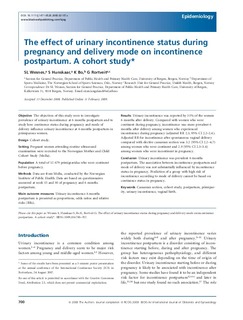| dc.contributor.author | Wesnes, Stian Langeland | |
| dc.contributor.author | Hunskaar, Steinar | |
| dc.contributor.author | Bø, Kari | |
| dc.contributor.author | Rørtveit, Guri | |
| dc.date.accessioned | 2009-06-17T12:24:16Z | |
| dc.date.issued | 2009-02-11 | |
| dc.identifier | Seksjon for idrettsmedisinske fag / Department of Sports Medicine | |
| dc.identifier.citation | British Journal of Obstetrics and Gynaecology. 2009, 116(5), 700-707 | en |
| dc.identifier.issn | 1470-0328 | |
| dc.identifier.uri | http://hdl.handle.net/11250/170705 | |
| dc.description.abstract | Objective The objectives of this study were to investigate prevalence of urinary incontinence at 6 months postpartum and to study how continence status during pregnancy and mode of delivery influence urinary incontinence at 6 months postpartum in primiparous women.
Design Cohort study.
Setting Pregnant women attending routine ultrasound examination were recruited to the Norwegian Mother and Child Cohort Study (MoBa).
Population A total of 12 679 primigravidas who were continent before pregnancy.
Methods Data are from MoBa, conducted by the Norwegian Institute of Public Health. Data are based on questionnaires answered at week 15 and 30 of pregnancy and 6 months postpartum.
Main outcome measures Urinary incontinence 6 months postpartum is presented as proportions, odds ratios and relative risks (RRs).
Results Urinary incontinence was reported by 31% of the women 6 months after delivery. Compared with women who were continent during pregnancy, incontinence was more prevalent 6 months after delivery among women who experienced incontinence during pregnancy (adjusted RR 2.3, 95% CI 2.2–2.4). Adjusted RR for incontinence after spontaneous vaginal delivery compared with elective caesarean section was 3.2 (95% CI 2.2–4.7) among women who were continent and 2.9 (95% CI 2.3–3.4) among women who were incontinent in pregnancy.
Conclusion Urinary incontinence was prevalent 6 months postpartum. The association between incontinence postpartum and mode of delivery was not substantially influenced by incontinence status in pregnancy. Prediction of a group with high risk of incontinence according to mode of delivery cannot be based on continence status in pregnancy. | en |
| dc.format.extent | 98076 bytes | |
| dc.format.mimetype | application/pdf | |
| dc.language.iso | eng | en |
| dc.publisher | Blackwell Science Ltd. | en |
| dc.subject | caesarean section | en |
| dc.subject | cohort studies | en |
| dc.subject | postpartum | en |
| dc.subject | primiparity | en |
| dc.subject | urinary incontinence | en |
| dc.title | The effect of urinary incontinence status during pregnancy and delivery mode on incontinence postpartum. A cohort study. | en |
| dc.type | Peer reviewed | en |
| dc.type | Journal article | en |
| dc.subject.nsi | VDP::Medical disciplines: 700::Clinical medical disciplines: 750::Gynecology and obstetrics: 756 | en |
| dc.source.pagenumber | 700-707 | en |
| dc.source.volume | 116 | en |
| dc.source.journal | British Journal of Obstetrics and Gynaecology | en |
| dc.source.issue | 5 | en |
